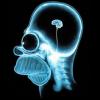Seems like opiates play a primary role in mediating serotonin induced prolactin release, and being that serotonergic based anti depressants elevate serum and whole beta-endorphin levels...this is the most probable cause, next to oxytocinergic dysfunction in explaining SSRI-induced sexual dysfunction and post-SSRI-induced sexual dysfunction....not sure if this has been discussed before, I just figured I'd throw this out there for all of those suffering from this and perhaps get some opinions on this topic.
EDIT : BETA-ENDORPHIN AND OPIATES also blunt oxytocin release - which is part of why they can be emotionally blunting in high concentrations. http://www.ncbi.nlm..../pubmed/6291011 ~ http://www.ncbi.nlm.nih.gov/pubmed/1971712
Seeing as how there a shit ton of people on here complaining of low libido and other issues, and even in cases where one hasn't used SSRI-antidepressants..opiates, particularly endogenous dynorphins and beta-endorphins are a plausible cause of generalized sexual dysfunction...
The reason why most remedies may help, but some have such a tough time dealing with these issues..is likely because the central alteration induced by serotonin is hard to reverse , and so one may either be stuck on one remedy but essentially isn't seeing the last part of the bridge, and how to cross it, so to speak.
INSIGHT IS A GOOD THING..AND SPARKS WONDROUS DEBATES.
http://www.ncbi.nlm..../pubmed/3621624
Clin Endocrinol (Oxf). 1986 Nov;25(5):573-8.
Evidence for serotoninergic system involvement in opioid control of luteinizing hormone secretion in man.AbstractEndogenous opioid peptides tonically inhibit LH by acting on hypothalamic mechanisms which regulate LHRH secretion. Opiates increase hypothalamic serotonin turnover but the involvement of the serotoninergic system in the opioid mechanisms regulating LH secretion in man is not clear at present. This study was designed to evaluate whether the tonic inhibitory effect on LH secretion induced by opiates involves the serotoninergic system. We have studied 10 healthy young men (aged 20-28 years). Five subjects were infused with naloxone (10 mg/h for 3 h) before and 120 min after fenfluramine administration (60 mg orally) on two different occasions. In five other subjects naloxone was infused before and after metergoline pretreatment (8 mg on first and second day and 4 mg on the third day, orally, at 0 time of naloxone infusion). After fenfluramine, naloxone infusion failed to induce any increase in LH plasma levels; metergoline pretreatment significantly enhanced the naloxone-induced LH increase. These data suggest that in man a hypothalamic serotoninergic system may be involved in the opioid mechanisms regulating LH secretion.
PMID: 3621624 [PubMed - indexed for MEDLINE]
http://www.ncbi.nlm..../pubmed/2435887
J Pharmacol Exp Ther. 1987 Mar;240(3):831-6.
Role of serotonin in opiate-induced prolactin secretion and antinociception in the developing rat.AbstractOur laboratory has demonstrated previously that the ability of opiates to stimulate prolactin (PRL) release during ontogeny precedes the appearance of a PRL response to serotonergic drugs. The present study tests the hypothesis that opiates stimulate PRL secretion through a serotonergic mechanism in adult rats, but a nonserotonergic mechanism in neonatal rats. Morphine stimulated PRL secretion in adult and neonatal (10-day-old) rats and this increase was blocked with the opiate antagonist naloxone. Ten-day-old or adult rats were pretreated with the serotonin antagonist, cyproheptadine (CYPRO), or the neurotoxin, 5,7-dihydroxytryptamine (5,7-DHT). Both CYPRO and 5,7-DHT attenuated the PRL response to morphine in adult but not neonatal rats. 5,7-DHT decreased serotonin and 5-hydroxyindoleacetic acid substantially in the hypothalamus. When rats were pretreated with 5,7-DHT several weeks before morphine challenge, serotonin depletion was more pronounced, but the PRL response to morphine was not decreased. In addition, the PRL response to 5-hydroxytryptophan was greatly potentiated, suggesting that functional supersensitivity developed in the 5,7-DHT-treated animals. The ability of CYPRO and 5,7-DHT to block the serotonergic component of a different morphine-induced behavior in the neonate was tested using the tail immersion test for analgesia. Morphine produced profound antinociception in the rat pup which was attenuated markedly by 5,7-DHT and CYPRO. These studies demonstrate that opiates mediate their stimulatory effects on PRL release, at least in part, through a serotonergic mechanism in adult rats.(ABSTRACT TRUNCATED AT 250 WORDS)
PMID: 2435887 [PubMed - indexed for MEDLINE]
http://www.ncbi.nlm..../pubmed/8294223
J Androl. 1993 Nov-Dec;14(6):407-10.
Treatment of idiopathic erectile dysfunction in men with the opiate antagonist naltrexone--a double-blind study.AbstractOpiate antagonists can indirectly stimulate the secretion of luteinizing hormone (LH) and testosterone, as well as sexual functions in animals and humans. We therefore treated 20 otherwise healthy men with idiopathic erectile dysfunction aged 46.3 +/- 2.7 years (mean +/- SE, range 23.9-63.3) in a double-blind study with an opiate antagonist, naltrexone, or placebo. The erectile dysfunction of these men had persisted for 3.6 +/- 0.5 years despite libido maintenance; standard procedures had excluded any organic causes. Trial duration was 12 weeks overall. After a 4-week forerun, the patients received at first 25 mg naltrexone/day orally or placebo for 4 weeks followed by 4 weeks of a 50-mg dose of naltrexone/day or placebo. Each day the patients filled out a questionnaire detailing libido, degree of erection, frequency of sexual intercourse, and spontaneous morning erections. Serum concentrations of gonadotropins and testosterone were determined radioimmunologically in the initial stage and at the end of each phase. Both patient collectives had similar initial factors. The group treated with naltrexone showed a significant rise in spontaneous early morning erections during the treatment: from 2.8 +/- 0.3 to 4.2 +/- 0.3 a week (P < 0.001). The placebo group showed no significant change in spontaneous erections (2.4 +/- 0.3 and 2.6 +/- 0.3, respectively). The subjective parameters, however, such as libido, degree of erection, and frequency of sexual intercourse showed no significant difference within each group. There was no difference in LH, follicle-stimulating hormone, or testosterone concentrations in both groups. Thus, treatment with naltrexone significantly raises the rate of spontaneous early morning erections when compared to controls.(ABSTRACT TRUNCATED AT 250 WORDS)
PMID: 8294223 [PubMed - indexed for MEDLINE]
http://www.ncbi.nlm....pubmed/10371024
Farmaco. 1999 Mar 31;54(3):130-3.
Serum beta-endorphin level in patients with depression on fluvoxamine.AbstractThe main interest of the present study was to determine possible alternations in beta-endorphin serum levels in healthy volunteers and in patients with depression, as well as changes in beta-endorphin serum levels caused by fluvoxamine treatment. Fluvoxamine maleate (Fevarin) was administered orally at a dose of 200 mg/day for 4 weeks. The serum levels of beta-endorphin were lower in patients with 'nonendogenous' depression (104.68 +/- 5.29 pg/ml) and those with 'endogenous' depression (36.34 +/- 2.23 pg/ml) than in healthy volunteers (125.19 +/- 1.64 pg/ml). The endogenously depressed patients had significantly lower beta-endorphin levels than the nonendogenous patients. A 4-week treatment of fluvoxamine (200 mg/day) caused a statistically significant increase in beta-endorphin serum levels in all patients (nonendogenous depression 132.10 +/- 2.38 pg/ml and endogenous depression 50.09 +/- 2.45 pg/ml) in comparison to values found before the onset of the therapy. The efficacy of fluvoxamine was 11.0 (+/- 9.0) evaluated by the Hamilton Rating Scale for Depression (HAMD) in the patients with a diagnosis of depression. These results indicate that determination of beta-endorphin serum levels could be a valuable laboratory test in the diagnosis of depression.
PMID: 10371024 [PubMed - indexed for MEDLINE]
Edited by Area-1255, 30 October 2014 - 04:15 AM.




















































